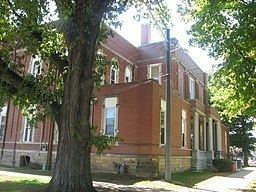- land 1.85 sq mi (5 km) - summer (DST) CDT (UTC-5) Population 2,815 (2013) Area code 618 | - water 0.00 sq mi (0 km) Area 4.791 km² Local time Sunday 7:53 AM Postal code 62448 | |
 | ||
Weather 13°C, Wind S at 13 km/h, 97% Humidity | ||
How to say or pronounce usa cities newton illinois
Newton is a city in and the county seat of Jasper County, Illinois, United States. The population was 3,069 at the 2000 Census. Newton is home to a large coal-fired power plant [2] and Newton Lake State Fish and Wildlife Area.
Contents
- How to say or pronounce usa cities newton illinois
- Map of Newton IL 62448 USA
- Geography
- Demographics
- History
- Education
- References
Map of Newton, IL 62448, USA
Newton has produced several notable natives. These include Texas Ranger pitcher Ross Wolf, folk singer Burl Ives, and Irene Hunt, who set the historical novel about the Civil War, Across Five Aprils, in and around Newton.
Geography
Newton is located at 38°59′17″N 88°9′52″W (38.988119, -88.164390). The city is located in the geographic center of Jasper County on a bluff overlooking the Embarras River.
According to the 2010 census, Newton has a total area of 1.85 square miles (4.79 km2), all land.
Demographics
As of the census of 2000, there were 3,069 people, 1,329 households, and 810 families residing in the city. The population density was 1,647.3 people per square mile (637.1/km²). There were 1,490 housing units at an average density of 799.8 per square mile (309.3/km²). The racial makeup of the city was 98.99% White, 0.10% African American, 0.20% Asian, 0.23% from other races, and 0.49% from two or more races. Hispanic or Latino of any race were 0.59% of the population. Among the White residents, the ancestral origin is primarily German with lesser contributions from England, France and Ireland. There were 1,329 households out of which 27.9% had children under the age of 18 living with them, 48.5% were married couples living together, 9.3% had a female householder with no husband present, and 39.0% were non-families. 35.4% of all households were made up of individuals and 19.6% had someone living alone who was 65 years of age or older. The average household size was 2.25 and the average family size was 2.94.
In the city, the population was spread out with 23.9% under the age of 18, 9.3% from 18 to 24, 25.4% from 25 to 44, 20.4% from 45 to 64, and 21.1% who were 65 years of age or older. The median age was 39 years. For every 100 females there were 84.9 males. For every 100 females age 18 and over, there were 81.2 males.
The median income for a household in the city was $30,280, and the median income for a family was $42,788. Males had a median income of $31,808 versus $17,877 for females. The per capita income for the city was $16,363. About 8.4% of families and 11.7% of the population were below the poverty line, including 20.7% of those under age 18 and 10.1% of those age 65 or over.
History
Newton is the largest, oldest and only city (although several there are villages) in Jasper County. Because of its favorable location within the county, it was named county seat in 1835.
Jasper County was formed in 1831 and approved on Dec. 19, 1834. The county was named after American Revolutionary War hero, Sergeant Jasper. He and his close friend, Sergeant Newton, were patriots that saved American prisoners of war from certain death at the hands of British soldiers. Thus, the county and town became their namesakes.
A post office was established in Newton in March 1883. The post office was not established in a building, but rather in a man’s hat. A rider brought the mail from Vincennes, Ind., made a stop in Newton once a week and then continued delivering mail on his route north of Newton.
By 1841 the town had increased to five families. Lawrence Hollenbock and Samuel Garwood built a saw and grist mill and Benjamin Harris opened the first grocery store in Newton. In 1855, Newton had Miller’s Hotel and a small inn known as The American House that is now Yesterday's and Today’s Pub. By 1865, the population of Newton grew to 300 and a decade later reached 400 people. In 1874 Joe Litzelman’s Hack Express began traveling daily to and from Olney on what is now Route 130. Today, Newton has a population near 3,000. The community is made up of local businesses, industry, a high school of less than 500 students and several organizations and churches.
Education
Newton resides in the Jasper County Community Unit School District 1, which is geographically the largest school district in Illinois. The schools in the town include Newton Community High School/Junior High, Newton Elementary and Saint Thomas Elementary School.
